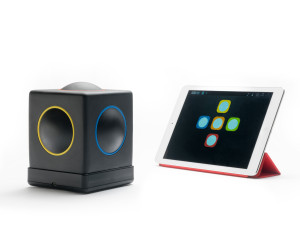Think outside the box of music making with Skoog 2.0!

Image courtesy of Skoogmusic
Abelton, AlphaSphere, ROLI Seaboard Rise, Ototo and more: The conception and development of technology that can give way to making melodies and enjoying the creativity of music, has been the exciting frontier of growth for music techies worldwide, for years now. Ideas and aspirations have gotten so unconventional that at this point, to combine modern technology with the idea of a musical instrument, is a pursuit seemingly only limited by one’s imagination.
First launched in 2009, Skoogmusic Ltd. is a developer company based in Edinburgh, UK. Settling into the music technology space along with the aforementioned amalgamation of other unique brands, Skoogmusic was initially an endeavor launched through the University of Edinburgh and the Scottish Enterprise High Growth Unit, by Drs. David Skulina and Ben Schögler, before receiving funding through Daedalus Capital, Barwell PLC, and the Scottish Enterprise Co-investment Fund the following year.
The flagship item created through Skoogmusic is the nearly eponymous, Skoog, which has just been released in a new and improved 2.0 form. A physical object designed for the creation of music by anyone, Skoog is a tactile cube that is everything from a teaching tool, to an instrument for jam sessions, to a flexibly accessible interface for creative people who have varying relationships with physical and emotional expression. The Skoog has evolved since its first incarnation and Skoog 2.0, recently launched last month, is currently making rounds at festivals and conferences throughout Europe, recently including Music Tech Fest (Berlin) and LAUNCH.ed.
First glance of Skoog presents onlookers with what appears to be an innocent object of child’s toy proportions. A cube with large, color-framed buttons, while friendly and uncomplicated in its design and basic form, Skoog packs a powerful punch in what the interface can do when teamed up with a fresh musical idea and the accompanying Skoogmusic app or desktop Mac/Windows/Linux software. Many manners of interaction with Skoog 2.0 – touching, twisting, or squeezing any of the cube’s buttons – elicits sound which comes through the (wirelessly or USB) synced device of choice – whether iPad, iPhone, laptop, or desktop.
Established, hybrid, musician-tech-songwriter enthusiasts can find lots of potential in applications for Skoog, as the interface can communicate with any additional app that supports MIDI capability (e.g. Garageband, Ableton Live, Orphion Nanologue, and ThumbJam). Sampling and recording capability through the Skoogmusic app means that anything players can imagine doesn’t have to get lost in the moment and can be preserved for enjoying later and the assortment of sounds programmed into the app allow Skoog’s voice to take on a variety of instrumental timbres, that can be changed at any time. Those who like to jam with favorite existing songs can also take advantage of Skoog. Able to sync with a person’s existing iTunes library or Spotify playlists, Skoog automatically sets itself to the proper key of whichever song is chosen and users can have their own improvised jam sessions to songs they already know and enjoy.
While Skulina and Schögler are constantly emphasizing Skoog’s appeal for all, there’s no understating the value and significance for what the cube is able to provide for young children who may have never otherwise been exposed to or been able to have a relationship with music because conventional ways of playing might not align with how a particular child interacts with other things and people around them. This element of Skoog’s functionality is something that shouldn’t be thought of as merely a move to tick off the “inclusion box.” Instead, think of it as more of a full creation, deliberately acknowledging that it’s not about bringing the atypical to the norm so much as widening what society acknowledges “the norm” to be in the first place, for this aspect of everyday life.
When asked where he thinks the highway of music creation and technology is heading, and if the team intended for Skoog to introduce children to more advanced tactile interfaces as time goes on, Dr. Schögler expressed an extension of the above mindset, not viewing the expansion of modern interfaces a sign of impending negativity between traditional instruments and contemporary invention:
“Tactility in musical interaction is on the rise! (pardon the pun) The key thing for us at Skoog is we have not created a ‘disabled instrument,’ just one that is easy to use and focused on kids. We see Skoog as a gateway technology much as you describe, that can open the door for young creative minds to start exploring digital music creation at a much younger age whilst supporting the needs of less able users at the same time. In the same breath, we also believe that Skoog has musical integrity and can be fulfilling in its own right. We are currently working to extend the range of apps and functionality of Skoog to expand the creative pallet for Skoogists young and old.
Music creation is growing, expanding, diversifying and we think that is very much a good thing. We don’t see that having a negative impact on the use of traditional acoustic instruments and the music we make with them but more that music is growing as a whole – more types of music to make and more ways to do it! The spectrum of opportunity is extending both in terms of creative access and professional expertise. We have more to play with now, and what we want to do is help people play more!”
Presently, Skoog 2.0 is being carried and highlighted by Apple through its newly lanched “Accessibility Accessories” shop section and retails for £199.95 GBP ($299.95 USD in the U.S.). Educators can contact the team with Skoog for additional resources connected with their products.
Get to know more about Skoog and Skoogmusic through the company’s official website and these social media outlets:
Facebook
Twitter (@SkoogMusic)
YouTube
Linkedin


Leave a Reply